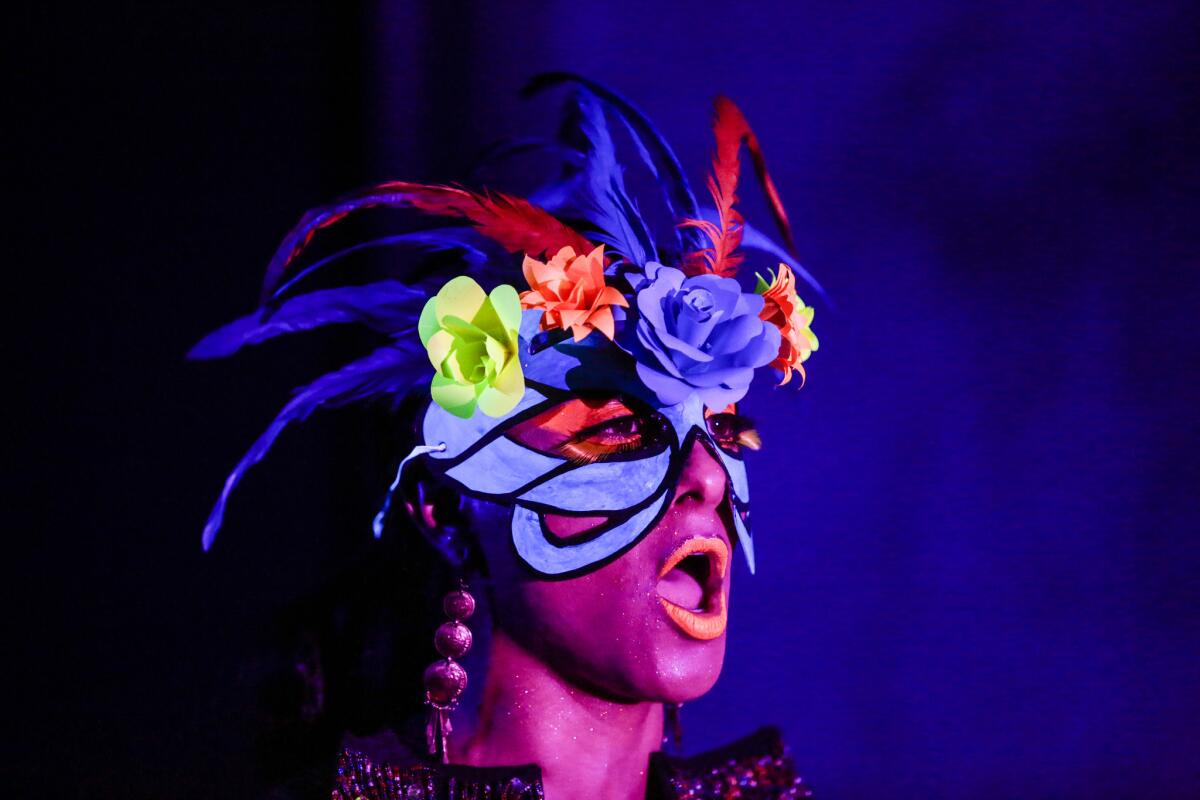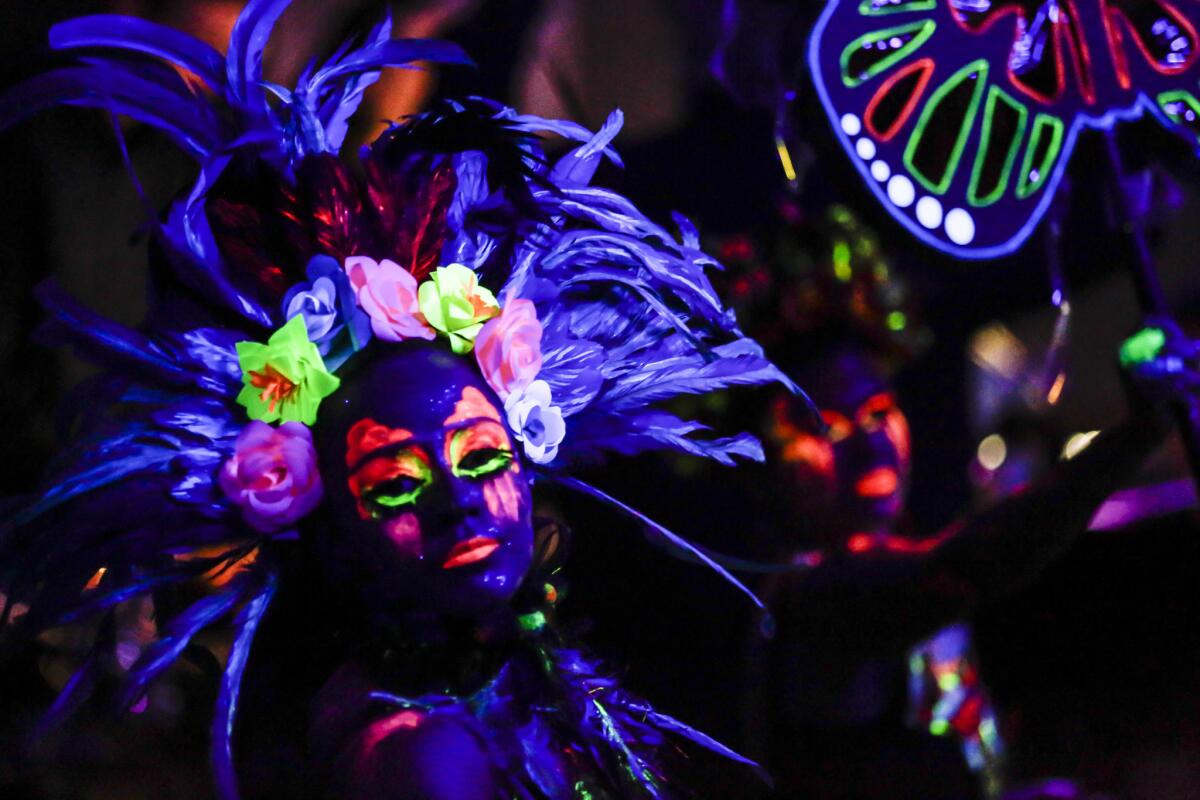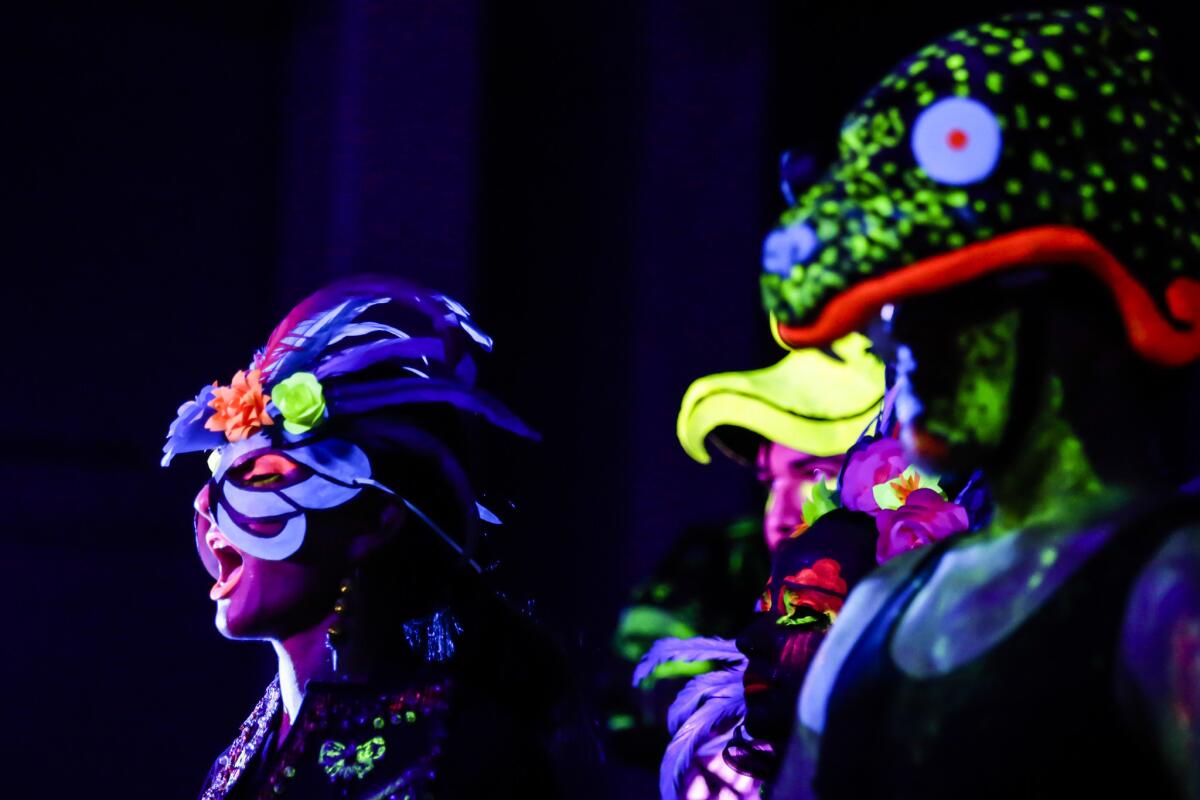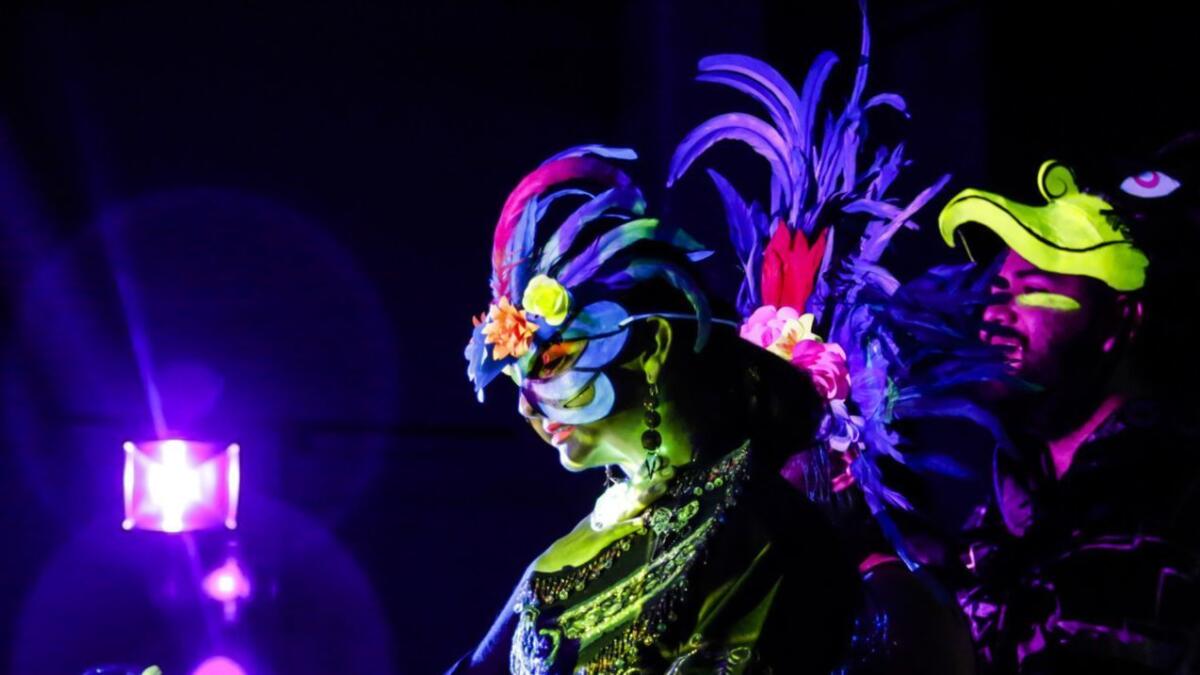Aztec opera ‘El Circo Anahuac’ shares volcanic love and loss in a mystical time before Mexico

- Share via
The smell of burning sage wafted into the small room on the fourth floor of LA Plaza de Cultura y Artes, as the sound of chirping crickets and croaking frogs filled the air. A percussionist began to beat out a rhythmic pattern on a bass drum, joined by a snare and tuba, as a masked couple walked into view to express a declaration of love. The music quickly turned into an upbeat circus tune, as four dancers leaped out from the wings, their heads adorned with flowers and feathers, their faces covered with fluorescent paint that glowed under the purple-hued blacklight.
This is the first scene of “El Circo Anahuac: An Aztec Opera,” a production that takes a centuries-old legend of tragic love and retells it with a contemporary twist. The opera is based on the Náhua origin myth of the twin volcanoes outside Mexico City, Popocatépetl and Iztaccíhuatl. According to the legend, an Aztec leader offered the hand of his daughter, Iztaccíhuatl, to the warrior Popocatépetl if he would return from battle victorious. While he was away, another jealous suitor told Itza that Popoca had died. Stricken with grief, she killed herself. When Popoca returned and found his beloved, he carried her body outside the city, where he too died of sadness, their love forever memorialized as the two peaks. It’s the story that inspired the ubiquitous image of the Aztec warrior cradling the body of his lost love, which adorns countless taqueria calendars throughout L.A.

Despite its eternal themes of star-crossed love, “El Circo Anahuac” began with much more mundane origins.
“We had an old washing machine. It made a rhythmic pattern, pa-pa, pa-pa, pa-pa...“ says David Reyes, a composer and musician who wrote the music for the production. The pattern had a circus feel, so he began writing an overture with a circus theme. Reyes then shared it with Maria Elena Yepes, a theatrical and entertainment producer, who was tasked with writing the libretto.
“I started researching circuses and nothing grabbed my attention until I saw an article about indigenous aerial artists who come down from a pole,” Yepes says. “I started researching that, before you knew it, I was reading about the Aztecs and I ran into the story of the twin volcanoes outside of Mexico City.”
The idea is to show that other cultures have something in the fine arts to contribute, that their stories are stories of value.
— Maria Elena Yepes
In writing the libretto, Yepes was inspired by Nahua poetry, especially the work of Nezahualcoyotl, ruler of Texcoco in the 15th century. In addition to being a leader, he was also a true Renaissance man, “a poet, philosopher, architect and librarian,” says Yepes.
Fittingly, the libretto is trilingual, incorporating Spanish, English and even some Nahuatl, which proved an exciting challenge for Reyes when writing the music.
“For me, English and Spanish was easy, but the Nahuatl was a little tricky, because they have L’s right after T’s,” Reyes says. “I would call Maria Elena up and ask, ‘how do you pronounce this word?’”
The production which recently completed a sold-out, four show run at La Plaza, takes the legend and wraps it up in a postmodern opera that fuses classical singing, with lively dance, and bold costumes. Due to popular demand, two additions shows have been added on Nov. 3 and 4.
Two singers play the lovers, while a third is a ringmaster who narrates the action. Four dancers adopt the characters of “spirit animals” for the pair, who guide and protect them, such as Monarca the butterfly and Quetzal the bird. Live music is provided by a stripped-down ensemble, similar to a traveling circus band. Artist and cartoonist Lalo Alcaraz is the principal designer, drawing on bold, Aztec motifs for the headdresses and props, which were then fabricated by Daniel González, who has previously created pieces for dynamo opera director Yuval Sharon.
Although they received some funding from a number of sources, including the Eastside Arts Initiative in partnership with LA Plaza, “El Circo Anahuac” is a bare-bones affair, forcing them to stretch their budget and resources. Certain scenes couldn’t be adequately reproduced with their limited stage space, so González created animations based on Alcaraz’s designs that were projected on a screen behind the performers. Certain songs had to be left out of this tight, 40-minute version, which the producers hope to restore in future renditions.
“I can’t wait to get this to a big theater,” beams Alcaraz enthusiastically. “Every time I see the show, I take notes.”

With its origin in Nahua myth, “El Circo Anahuac” can be seen as part of a growing movement to “decolonize” the arts, although its fusion of Western and indigenous sources points to a more complex synthesis. Janelle Gonzales, the show’s choreographer, said she drew on her training in postmodern ballet, as well as danza azteca and zapateado, a group of Mexican dance styles involving rhythmic footwork.
“In ballet, we’re trained to lift, not to sound like elephants,” she told the audience after Saturday’s performance, “but here, I want you to feel the floor.”
Last spring, Yepes and Reyes brought a rough version of “El Circo” to the high school in L.A. “High school students are a rough crowd,” Yepes says, “but they loved it. They were asking really good questions.” The students filled out questionnaires, which helped them develop the work.

During a Q&A on Saturday night, a teacher asked how she could get the production to her school. “My students don’t know that there are people who look like them who sing opera,” she said, to which Alcaraz shouted from the back of the room: “Representation matters!”
For Yepes, this representation includes not just those on stage, but the narratives they act out as well. “For me, the idea is to show that other cultures have something in the fine arts to contribute, that their stories are stories of value.”

‘El Circo Anahuac: An Aztec Opera’
Where: LA Plaza de Cultura y Artes in Downtown Los Angeles
When: Saturday, Nov. 3, 7 p.m. & Sunday, Nov. 4, 5 p.m.
Price: $30 – $50, tickets available at Eventbrite.
More to Read
The biggest entertainment stories
Get our big stories about Hollywood, film, television, music, arts, culture and more right in your inbox as soon as they publish.
You may occasionally receive promotional content from the Los Angeles Times.










